Decorating the outside of the house: types of finishing materials, their advantages and disadvantages
When constructing the walls of a house, external finishing of the facade may be required.This need arises when second-rate building materials are used, the façade loses its attractiveness, or when repaired cracks need to be masked. But the exterior of the building speaks of the respectability and status of the owners. Do you agree?
We will talk about how and using what materials the exterior of the house is finished. We will tell you what is better to choose and how to install the cladding so that it is durable, beautiful, and reliable. Taking our advice into account, you can forget about facade repairs for many decades.
The content of the article:
Basic rules for exterior decoration
To maintain normal humidity levels in the room, the cladding must have high vapor removal rates.
The building material from which the wall is made should be less vapor permeable than thermal insulation layer, which, in turn, is less susceptible to vapor than the material for external wall cladding.
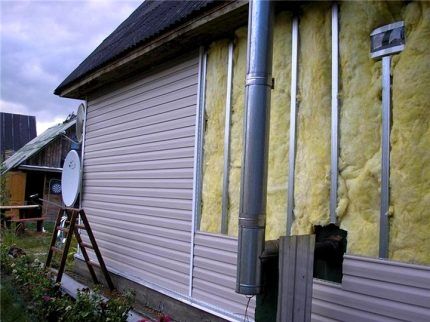
If the characteristics of the materials do not have the necessary vapor permeability, condensation will accumulate at the boundaries of the layers, creating favorable conditions for the growth of mold, fungi, and rotting of surfaces.
When the temperature drops, the sedimentary moisture will freeze, which will lead to the destruction of the wall and finishing. After several years, the facade will have to be changed.
Before deciding how to decorate the outside walls of a house, you need to familiarize yourself with the technical characteristics of the materials. Although it is clear that all facing panels and sheets, except wooden ones, have a low vapor emission index.
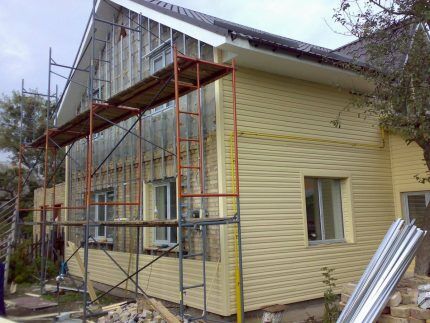
If you choose cladding made of artificial materials with low vapor permeability, it is necessary to provide a façade design in which vapor emission will occur in a different way.
The problem can be solved in two ways:
- Install a ventilated façade. To do this, vapor-permeable thermal insulation and ventilated gaps are placed between the wall and the finishing material, on the basis of: on each section of the wall with an area of 20 sq.m., including windows and doors, there is a gap with a useful volume of 75 sq.m. cm.
- Cover the inside of the wall with a layer of vapor barrier. In this case, the cladding can be attached to the wall of the house, without an adjacent insulating layer. Due to the vapor barrier coating, moisture does not appear on the surface of the wall and finishing material, the structure remains dry, so the cladding material can be selected without taking into account vapor permeability.
In the first option, the upper part of the holes remains open to evaporate vapors. The facade in this case performs a protective and decorative function.
With the advent of expanded polystyrene, the second method of wall cladding began to be used more often. Extruded polystyrene foam has low vapor permeability and is an effective heat insulator, which allows you to save on space heating.
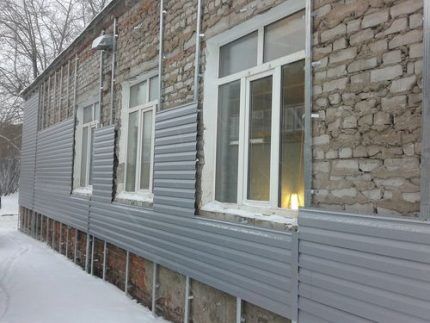
When finishing the walls from the inside, any facing material can be mounted on the façade, from wooden panels to porcelain tiles.
Siding for facing a house
The most affordable option for finishing a house is siding. The material has a lower cost than wood, lumber, ceramics, has a long service life, and therefore is used much more often than other facade coatings.
Siding can be used to cover walls built from any material with any external insulation option. A facade equipped in this way is ventilated, since the materials are mounted on a prepared sheathing, so this coating is universal.
Option number 1 - vinyl panels
Vinyl siding is made from high-tech polyvinyl chloride, which is used in various climate zones. It can be easily cut to form the correct facade of houses with uneven walls, protrusions, and many decorative elements.
The material is flat strips 10-12 mm thick, 205-255 mm wide. The siding is attached to the facade using a perforation line for fastening and docking locks connecting the two panels to each other.
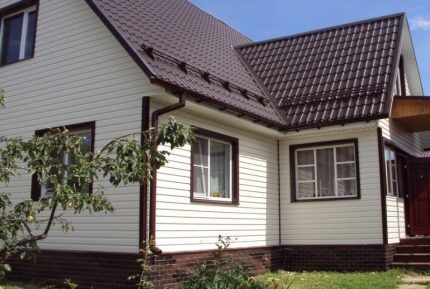
Installation of vinyl strips is carried out on a metal or impregnated wooden sheathing, consisting of starting and side additional beams. The screws are screwed in in such a way that there is some play left for possible changes in the siding under the influence of temperatures.
A type of vinyl panels is basement siding. Only in this case, the panels do not look like stripes, but like a square or rectangular part of the wall.
The material is thicker than vinyl panels, as it is designed to protect the roof base from precipitation and other influences. But because of its practicality and strength, it has become widespread when cladding facades.
The basement facade is attached to the sheathing, which is attached more tightly, due to the fact that the panels have the shape of a square or rectangle of shorter length.
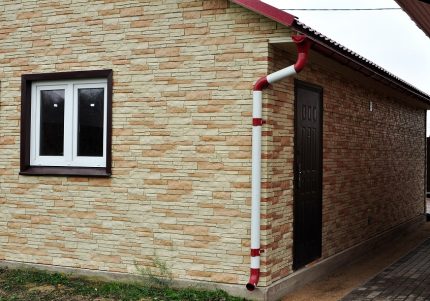
To mount the panels, each panel has perforation and a connecting lock. When screwing in self-tapping screws, you should leave some play to compensate for possible movements of the material.
Basement siding imitates natural materials better than others. Therefore, with skillful installation, it is possible to distinguish an artificial facade from a wall made of stone or brick only by directly touching the wall.
The advantages of vinyl siding are:
- Easy installation on buildings of any configuration.
- Affordable price of material.
- Installation of a façade made of vinyl siding is possible at temperatures from -5 to +40 °C.
The disadvantages include rapid fading on the sunny side of the building, so it is better to choose light shades of panels.In addition, installation at low temperatures from -5 ° C will increase the number of trims, since the siding will burst with minor bends during processing.
Option No. 2 - metal siding
Metal siding is made from aluminum or galvanized steel. A dye is applied to the surface to perform a protective function.
The material is decorated in two ways:
- Covered with a polymer shell. Such panels do not fade and are resistant to mechanical stress. During polymerization, manufacturers use a limited number of shades.
- Powder painted. With this treatment, the paint does not fade and can be used for a long time at any temperature without signs of peeling. The panels have a variety of colors and shades.
Installation of metal panels is carried out on load-bearing and additional side beams using self-tapping screws and connecting locks on the strips.
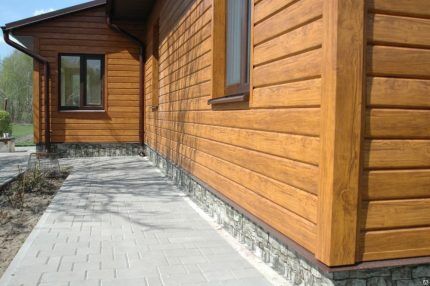
The advantages of such panels include their low price, durable coloring without fading of colors on the sunny side of the building. In addition, metal panels are easy to work with at any time of the year, they bend well, do not break, and are suitable for cladding round structures.
The disadvantage is the aesthetic simplicity of metal strips. If the installation is unsuccessful, the building looks more like a production workshop.
Fiber cement panels for finishing
Fiber cement boards and siding for exterior cladding consist of wood fiber, cement, laminated mica, and quartz.In production shops, when making panels, chlorine and asbestos are added to the solution, so such products can only be used for exterior wall decoration.
This mixture is used to form sheets and strips of various sizes. After this, the panels are dehydrated through several technological processes, fired and coated with a protective and decorative composition.
The composition can be:
- acrylic — fading time 8-10 years;
- hydrophilic-ceramic — fading life 30 years;
- photoceramic — fading time is 10-15 years.
With photoceramic coating, the panels are easily cleaned from dirt. The price for such slabs is affordable, and the significant size of each panel allows you to save time when arranging even a large building. Therefore, when deciding how to quickly cover the outside of a large house, pay attention to fiber cement panels or slabs.
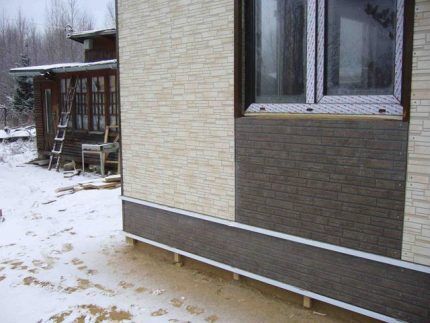
Monolithic slabs are attached to guide strips using clamps. When installing fiber cement siding, the panels are overlapped.
Fiber cement facade slabs are strong and durable. For molding, natural, eco-friendly materials are used that are not subject to combustion, so a structure sheathed with fiber cement sheets is considered fireproof.
A wide variety of patterns and textures, the possibility of installing glossy or matte slabs, allows home owners to be creative when cladding the facade of the house.
If the production technology is violated, the slabs may have a significant degree of steam penetration, then to eliminate the problem it will be necessary to install additional waterproofing and varnish the façade coating.
Wooden materials for cladding
Wood is the only material that has good vapor permeability. Wooden products can be mounted on a wall made of any material, but they work best in cladding of a wooden house. Any thermal insulation material can be used.
Natural moisture transfer will not allow steam and condensation to accumulate on wood surfaces; the wall will always be dry, which will prevent its destruction. However, direct contact of wall materials with cladding lumber should be excluded. There must be a ventilation gap between them.
Wooden products for exterior decoration include:
- Block house. The block house building looks like a house built from rounded logs.
- Imitation of timber. In this case, the material imitates planed timber.
- Lining. A more affordable wooden material for cladding the facade of a house.
- Dies, shingles, shindles and planks. Small boards of wood are suitable for decorating the facade of a building for a hardworking owner.
Installation of wooden cladding is carried out on the sheathing. Basalt wool is laid in the spaces between the beams, after which the wooden sheathing is attached.
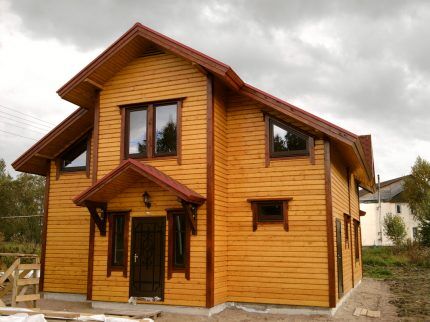
The advantages of wooden cladding include its environmental friendliness, excellent heat and sound insulation.The walls of the building, under wooden cladding, are protected from mechanical influences, precipitation and temperature changes.
Disadvantages include flammability and the presence of natural defects, due to which a lot of residues are formed during primary and subsequent processing.
With proper annual care of the wood, the facade will last for many years. But if there is no possibility and desire to constantly treat the surface, use other materials, since wood in its natural state is susceptible to rotting, pests and darkening.
Finishing with natural and artificial stone
The beauty of the façade will be ensured by natural and artificial stone for many years. Materials for wall cladding are made in the form of slabs with smooth, rough and textured coating.
Facade natural stone slabs are formed by processing the following materials:
- marble;
- granite and syenite;
- limestone and sandstone;
- slate;
- dolomite;
- quartzite;
- gabbro;
- labradorite;
- purple;
- breccias.
Fake diamond It is produced by molding a mixture of cement, sand and stone chips of various fractions. Expanded clay, ceramic chips, natural pumice and expanded perlite are used for crushing.
When making artificial stone slabs, the finished products at first glance do not differ from natural ones, but they have less weight. In addition, the collection of facade coverings made of artificial stone has absolutely fantastic colors, shades and textures.
To cover the facade with stone panels, it must be prepared so that the maximum surface unevenness does not exceed 2 cm. After preparing and cleaning the wall, the reinforcing mesh is fixed.Next, the tiles are laid on the facade using cement mortar.
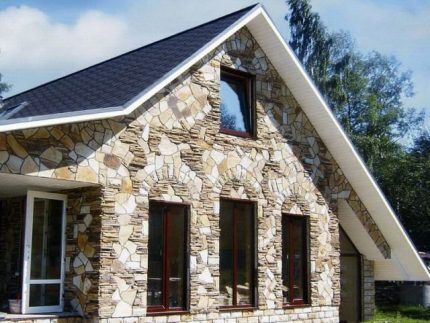
In the manufacture of artificial slabs, natural stone chips, high-grade cement and clean sand are used.
Therefore, the material created in industrial conditions and natural rocks have the same advantages, which include:
- Strength, resistance to any deformation.
- Durability, fade resistance.
- Durability to temperature changes and precipitation.
The main disadvantage of facade stone is its high price. The most expensive materials are granite and marble, the most affordable are sandstone, limestone and artificial analogues of natural stone slabs.
Facade of a house made of facing slabs
Facade materials for wall decoration are used everywhere, as this is an excellent opportunity to protect the load-bearing walls of a building from humidity, temperature fluctuations, precipitation, pollution, and mechanical influences.
Therefore, manufacturers of building materials have developed cladding slabs that have a low price and good performance characteristics.
So, for cladding facades they use:
- gypsum decorative tiles;
- clinker tiles made of refractory shale clay;
- terracotta tiles made of unpainted kaolin clay (ceramic);
- porcelain stoneware panels.
Porcelain stoneware panels are large and heavy, so they are attached to beams using clamps.Clay and gypsum panels are mounted on the wall of the house with cement mortar, followed by grouting.

In the production of facing slabs from minerals and crushed rocks, the materials go through the stages of crimping and firing, therefore these façade coatings:
- have increased strength;
- safe for people, as they are made from natural materials;
- are light in weight;
- do not lose their original appearance and color;
- have a wide range of shades and textures.
During the firing process, facing slabs completely lose their elasticity and break at the slightest deformation, especially in the winter season. Therefore, all work with these materials should be postponed until the summer.
Facade plaster for external cladding
Facade plaster for cladding buildings has a different composition, texture and binding element. Components for plaster are selected depending on climatic conditions, frequency of precipitation and type of primer.
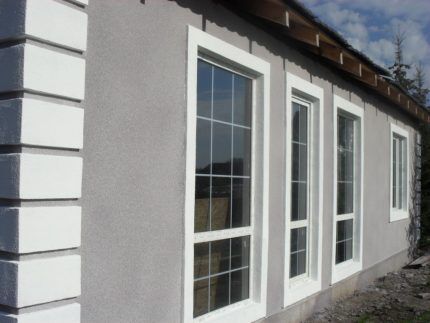
Applying plaster to a substrate that tends to expand/contract with changes in humidity levels requires precautions to be taken to prevent cracks in the finish. Therefore, a plastic binding element is added to the solution.
In this regard, in the process of preparing components for the solution, it is necessary to familiarize yourself with the characteristics of the finish and the climatic conditions of the region. Then properly selected plaster will last for several decades.
In addition, facade plaster when facing a house has the following advantages:
- protects walls from precipitation and mechanical influences;
- gives the building a unique look, as it can be applied in the form of decorative textures of various colors;
- has high adhesion, elasticity and safe composition;
- resistant to UV rays and temperature changes.
A high-quality composition applied to the walls of a building has many advantages. But if during the mixing process the proportions of raw materials were not observed or second-rate materials were used, then in the first season the plaster will partially fall behind the wall, crumble, and the façade of the building will have to be renewed again.
If you decide to insulate your house before performing façade cladding, pay attention to a technologically advanced and practically waterproof Penoplex. Our recommended article will introduce you to its characteristics, varieties and advantages of use.
Conclusions and useful video on the topic
The cheapest option for covering a country house:
Informative video about the installation of facade panels, analysis of the nuances and details:
If the cladding technology is followed and the materials are properly maintained, the façade of the building will be in use for at least ten years. Therefore, before deciding on the best way to cover a residential building, analyze the advantages and disadvantages of each type of finishing material.
Would you like to talk about how you selected the material to decorate the facade of your own house or cottage? Do you have your own opinion and compelling arguments that justify your personal choice? Please write comments in the block below, ask questions and post photos on the topic of the article.




Yes, there are not enough colors in metal siding, but besides this, it has plenty of disadvantages. In the summer in the sun it quickly heats up, in the heat you can’t get close to the walls, and in the winter if you don’t insulate the house first, then no pipes will really help you warm up. It is better to finish it with PVC panels. If you want to protect your home from fire, then you should buy vinyl panels marked G1. These do not burn, but smolder slowly.
Almost everyone I know who has finished the outside of their house or cottage has siding. The reason is simple - price. But, to be honest, these houses, especially when they are in a row, one after another, are like metal trailers. This is the feeling I get. Therefore, I decided to save up for my house and saved up for stone finishing. Artificial, true (also due to cost), but the appearance of such walls pleases me much more. By the way, I want to say that if you are going to decorate the walls with stone, then they should have the freshest plaster on them, no options from last year or even six months ago. If the plaster falls off, you will have to redo the entire finish. It will cost a pretty penny. Don't rely on the grid alone - it's not enough.
Siding finishing is popular not only because of its low cost. Plastic siding is very durable - once done and forgotten.